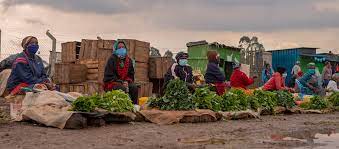·
CAREN GROWN AND CAROLINA SÁNCHEZ-PÁRAMO
In the spring and summer of 2020, large parts of the world were hunkering down as governments locked down societies and economies. Millions of families were confined to their homes. Across the globe, people were losing their lives and livelihoods to the COVID-19 pandemic. At the time, we only had a hunch about how the pandemic would play out differently for different people. We asked ourselves: How is COVID-19 going to affect gender equality across the world? Would the pandemic take a distinctly different toll on men and women?
Now, 14 months later, we still do not have all the answers. But in an effort to respond to the question and based on a review of new data by the World Bank, the United Nations and others, we have gathered a few.
The answer, one year on, is that men and women have experienced the crisis in markedly different ways. While men have been more likely to lose their lives from COVID-19, women have lost out more than men in terms of jobs, income, and safety. The data and research we reviewed tell us about the disparities in different dimensions of gender equality: Firstly, they tell us about people’s health and education (“endowments”). Secondly, they tell us about their livelihoods and earnings (“economic opportunities”). Thirdly, they tell us about voice and the power to make decisions (“agency”). And they tell us about the unequal economic and domestic experience of the crisis for men and women.
In a complex and diverse world, we can only identify general patterns. A whole host of other factors, such as age, education, income, disability, and ethnicity, will be reflected in people’s experience of the COVID-19 crisis. Those factors intersect with gender and influence women and men’s vulnerability and resilience.
When it comes to health, men have generally suffered higher death rates and higher rates of COVID-19 infection than women. In the South Asia region, more than 3 out of 4 COVID-19 related deaths were among men — and as high as 61 percent in Latin America and the Caribbean and 59 percent in the Middle East and North Africa. High male mortality rates can also have painful impacts on the survivors left behind, especially women who, most likely, have lower earnings and will need to recoup the income of the male earner.
Women’s health has suffered in other ways, however. Whether you were a woman in Armenia, Pakistan, or Senegal, you were more likely than a man to be experiencing stress and worry related to COVID-19. In Pakistan, 82 percent of women compared to 74 percent of men reported experiencing stress symptoms due to COVID-19. In Senegal, women reported being extremely worried more often than men (56 percent versus 46 percent). In Armenia, anxiety levels were higher among women: 43 percent compared to 29 percent among men reported the most severe level.
With regard to education, we find little evidence for earlier hypotheses that families would redirect scarce resources to prioritize education of boys over girls. However, evidence on this topic is scarce, as internationally comparable data from a wider range of countries on what has happened in contexts where schools have reopened is not yet available. Projections suggest that gender differences in school dropouts due to the crisis may differ across regions and levels of education.
According to UNESCO´s projections from July 2020, boys are at a greater risk of not returning to education than girls at university, primary and lower-secondary school, while the opposite holds for pre-primary and upper secondary education. However, girls appear to be especially vulnerable in certain regions: In Sub-Saharan Africa (SSA), for instance, a higher share of girls across all education levels (other than pre-primary) is estimated to be affected. Adolescent girls face a particularly high risk of not returning to school in both SSA and South Asia, where most at-risk students live.
When it comes to jobs, gender mattered, and mattered more than education, location, or generation. Women were more likely to lose their jobs in the first months of the crisis, as shown in a recent study by Maurice Kugler and colleagues based on harmonized high-frequency phone survey data for 40 mostly developing countries. Women workers’ likelihood of losing their job between April and June 2020 was 36 percent compared to 28 percent among men. In another study for Latin America, women had a 44 percent higher chance to lose their jobs at the onset of the crisis compared to men. Evidence on how job losses of men and women evolved after the initial phase of the pandemic is still scarce, but the available data suggests that women have been slower to return to paid employment than men. Businesses with female top managers also appear to have experienced more negative impacts than those led by men across countries. Some of these differences are related to the fact that women have shouldered the responsibility for additional care needs with school closures and the increase in ill family members, further restricting their time availability and their ability to return to work as economies reopen.
In addition, women have lost out in terms of personal safety. While the data is sensitive and not easy to obtain, different sources point in the same direction: a significant rise in violence against women. There were steep increases in calls to helplines, increased number of cases in service provider registries, in police reports, and, in a few cases, in dedicated surveys on the topic. For instance: In Indonesia, 83 percent of respondents reported increased intimate partner violence in their communities due to COVID-19. Similar to education, we do not have a complete and consolidated answer when it comes to whether and how teenage pregnancy rates and child marriage rates have been affected by COVID-19. We need more and better data, and we need it urgently.
Data scarcity limits the extent to which clear takeaways can be formulated one year into the pandemic. Data limitations affect the quality and depth of the information that can be presented. Information on the socioeconomic impacts of COVID-19 has largely come from remote surveys, which pose challenges in measuring the gendered impacts of COVID-19, including related to respondent selection, length of survey, and coverage of topics. With regard to violence against women and girls, only a few surveys have assessed reporting rates by women, while most other data sources are based on service providers, police reports or social media analysis. Furthermore, education, child marriage and teenage pregnancy are dimensions in which data and analysis are too scarce to be able to draw any conclusions.
In spite of those caveats, we can clearly see that COVID-19 casts different shadows over the lives and livelihoods of men and women. More importantly still, it has raised questions about how best to respond to ensure resilience for all in the recovery. The data we do have has shed fresh light on gender equality and unequal experiences of COVID-19. The main challenge now will be to harness this new data and analysis and translate it into policy actions that lead us out of the crisis stronger and better prepared for the future. Gender gaps across endowments, economic opportunities and agency predating the pandemic have mostly widened through this crisis. A concerted effort to empower women and girls worldwide is needed, not only to narrow and close those widened gender gaps but also to prevent women and girls from falling behind again in subsequent shocks.




